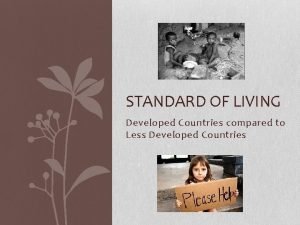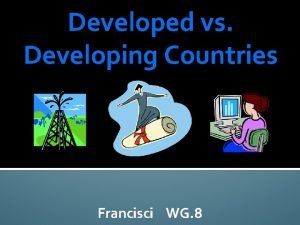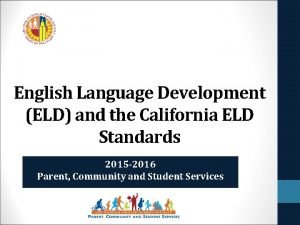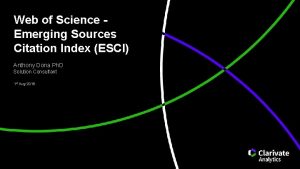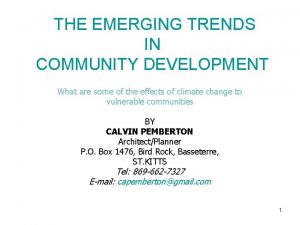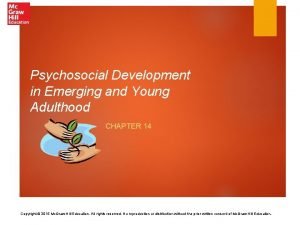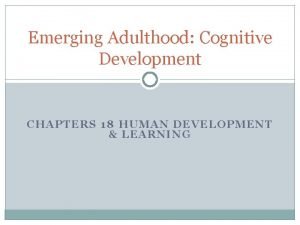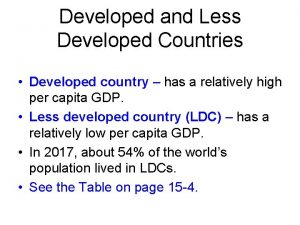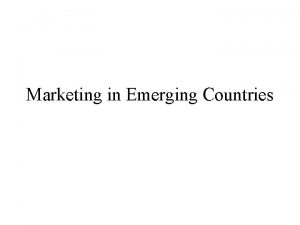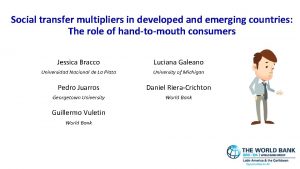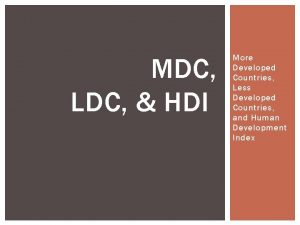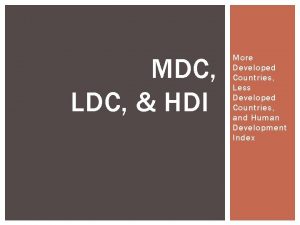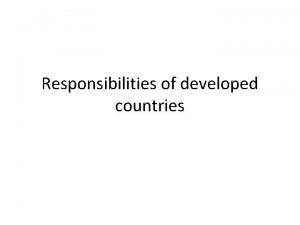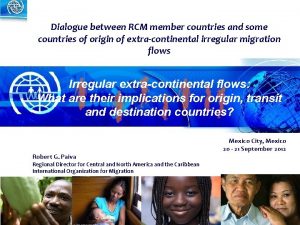Do the Emerging and Developed Countries Share the

































- Slides: 33

Do the Emerging and Developed Countries Share the Same Food Safety Concerns? Dr. Stan Bailey President, International Association for Food Protection Director Scientific Affairs - Industry, bio. Merieux

Our Mission: To provide food safety professionals worldwide with a forum to exchange information on protecting the food supply.


Worldwide recognition as the leading publication on food safety Available Online!

General Membership Publication for Association news, with articles on applied research and food safety applications

IAFP Report is a general membership monthly electronic publication featuring Association updates, global news and resources, and topics of interest to food safety professionals.

Flexible Membership Structure Basic Membership $50 ($25 for students) Membership with Journals From $86 (from $43 for students) All prices reflect US dollars Shipping Category US Add Canada Add Mexico Add International Add Maximize your benefits by adding one or more of our esteemed journals to your Basic Membership rate. Students receive up to half off rates listed below. Food Protection Trends Journal of Food Protection Online Choose All Benefits (best value) $60 $75 $90 $150 $170 $200 $36 $36 $200 $235 $280

IAFP Annual Meetings The Leading Food Safety Conference 2010 August 1 -4 Anaheim, CA July 12 -15 Grapevine, TX 2011 Milwaukee, WI

IAFP International Meetings IAFP Asia, Seoul, Korea - 2009

Timely Topics and Rapid Response • Fresh Leafy Greens - Are They Safe Enough? • Prepared – Not Ready to Eat Foods • Raw Milk Consumption: An emerging Public Health Threat? • Salmonella in Peanut Butter Outbreak Lessons Learned and Likely Consequences

Global Food Safety Emerging and Developed Countries - Food Safety or Food Security -

Food Science 101 • Bacteria (pathogens or spoilage bacteria) growth is predicated by temperature, moisture, and access to nutrients • Keep cold foods cold (< 4°C) and hot foods hot (> 65°C) • Primary methods of preservation of foods – refrigeration, water activity (drying or solutes), or acidity • Other variables by location – cultural practices, competitive flora • Basis for some religious teachings about foods

World Hunger Facts • About 6. 5 billion people in world • More than 850 million people in the world are malnourished — 799 million of them live in the developing world. • More than 153 million of the world's malnourished people are children under the age of 5. • Six million children under the age of 5 die every year as a result of hunger.

World Hunger Facts • 54 nations currently do not produce enough food to feed their populations, nor can they afford to import the necessary commodities to make up the gap. Most of these countries are in sub-Saharan Africa. • Lack of dietary diversity and essential minerals and vitamins also contributes to increased child and adult mortality. Vitamin A deficiency impairs the immune system, increasing the annual death toll from measles and other diseases by an estimated 1. 3 million-2. 5 million children.

Food Security • 850 million people (13% of world’s population) go to bed hungry every day. They are far more concerned about finding something to eat (Food Security) than about the safety of their food. • In many countries, safety of water will need to be achieved before safety of other foods will be considered

Waterborne disease WHO, 2004 • Account for 4. 1% of total global disease • 88% of 1. 8 million total deaths caused by diseases is waterborne • Waterborne disease can be caused by protozoa, viruses and bacteria • The intestinal parasite, schistosomiasis alone may account for 200, 000 cases and 200, 000 deaths each year

Waterborne bacterial disease - often from human and animal waste • Vibrio – cholera – parahemolyticus • Campylobacter • Diarrheogenic E. coli – O 157: H 7 and many others • Shigella

Estimating Global Disease Burden WHO is taking the lead • 1990’s: England, Wales, the Netherlands – Prospective Cohort Studies • 1990’s: US – Cross-sectional surveys compared to clinical observations • Early 2000’s: Australia, Canada, Ireland – Similar to US cross-sectional surveys

Estimating Global Disease Burden WHO is taking the lead • 2002: WHO Consultation recognized many areas of the world underrepresented and establishment of sentinel site countries, Jordon first site (Salmonella, Shigella, Brucella) • 2004 and 2007: major consultations to facilitate data sharing and methodology for better understanding the global burden of disease

WHO, 2007 • Consultation in Geneva developed a strategic framework with an evidence map, time frame, and proposed elements of a standard protocol for conducting burden of illness studies

Pulse. Net International • • • -Pulse Net USA -Pulse Net Europe -Pulse Net Asia-Pacific -Pulse Net Latin America -Pulse Net Middle East

Pulse. Net Middle east

Why is Food Safety our Top Priority? (for any company, country, or commodity) • It is a cost of doing business • The changing global food safety landscape demands more diligence, flexibility, and speed than ever before. • The cost impact of not doing food safety right is higher than it’s ever been. • The benefits of doing food safety right contributes directly to the bottom line – and not just in cost avoidance. • Consumer and regulatory scrutiny are at an all time high. • World class companies that win in the marketplace have world class food safety principles

Why Focus on Food Safety • Consumer and regulatory scrutiny are at an all time high. • The benefits of doing food safety right contributes directly to the bottom line – and not just in cost avoidance. • World class companies that win in the marketplace have world class food safety principles. • The changing global food safety landscape demands more diligence, flexibility, and speed than ever before. • It is a cost of doing business

Factors Impacting Food Safety • There a number of factors directly impacting the safety of today’s food supply: – – – Globalization of our food supply Increased regulatory and public scrutiny Intensive animal husbandry and agricultural practices Demographic changes and consumer behavior Climatic and environmental changes

Factors Impacting Food Safety: Globalization of Our Food Supply • Sourcing of food ingredients and commodities from outside of the U. S. has grown dramatically over the last ten years – – • Food imports to US from developing countries is skyrocketing (2007 projections): – – – • From $32. 44 B in 1996 to $64. 03 B in 2006 Projected to grow to $70. 0 B in 2007 Mexico/Central America South America China/Asia Africa Middle East $13. 2 B $ 9. 0 B $10. 9 B $ 1. 6 B $ 0. 8 B IMPLICATION: Imported foods, especially from developing countries, may be riskier as food safety systems are sometimes rudimentary or non-existent

Factors Impacting Food Safety: Intensive Animal Husbandry and Agricultural Practices • • • The world’s population is projected to grow to over 7. 8 B people by 2025 An estimated 20 million acres of farmland is replaced annually due to growing populations and urbanization Given these trends, large-scale, intensive animal production and farming practices are projected to accelerate in future years – – – • In the U. S. , intensive animal husbandry accounts for ~53% of total domestic agricultural income As a result, about 130 times more animal waste is produced than human waste – roughly 5 tons for every U. S. citizen. Manure has been the source of pathogens in a number of major foodborne illness outbreaks IMPLICATION: Increasing pressure from ranching and farming practices on the environment will increase the likelihood of pathogens entering the food supply

Factors Impacting Food Safety: Demographic Changes • International migration will continue to be a major factor impacting foodborne illness around the world – • The aging of the population is a major factor impacting food safety – – • Changing ethnicity patterns result in changing food preferences and practices that can result in food safety issues The population aged 65 years and over is projected to increase by 78. 6% by 2025 Infectious diseases, including foodborne diseases, are a problem for the elderly because of declining immune function Other segments of the population that are more susceptible to foodborne disease include pregnant women, neonates, and the immunocompromised – It is estimated that 20 -25% of the population is at increase risk for foodborne disease at any given time

Factors Impacting Food Safety: Changes in Consumer Behaviour • Changing trends in food consumption patterns impact food safety as consumers are eating more fresh produce, fish and other seafood and organically grown foods • Consumers engage in risky food safety practices despite health warnings and recommendations • IMPLICATION: New technologies and systems are needed to ensure the safety of today’s consumer-preferred food products. New approaches to consumer education are needed regarding safe food handling practices

Factors Impacting Food Safety: Increased Regulatory and Public Scrutiny • The U. S. Centers for Disease Control and Prevention (CDC) and similar bodies in other countries have in place a foodborne epidemiologic and surveillance network (Pulse. Net and Foodnet at CDC) that enables the rapid detection of foodborne outbreaks • Regulatory bodies (FDA and FSIS in the U. S. ) are constantly implementing new policies to try and reduce food safety outbreaks • Food Safety is increasingly being used as a barrier in international trade of food

Pathogenic Bacteria do not recognize countries borders - E. coli 0157: H 7 and other shiga-toxin producing E. coli - Antibiotic resistant Salmonella including S. Typhimurium DT 104 - Vibrio’s associated with fish and shell-fish shipped around the world - Many others

National food laws and their underlying food safety measures and conformity assessment systems should be guided by the following principles • Only safe and wholesome foods should be marketed; • Food safety is science-based; • Transparency, education, and a strong scientific underpinning equals public confidence in the safety of your food supply.

Conclusions: • Food safety and security issues in emerging and developed countries are different • Even though there are different challenges in emerging countries, establishment of safe food production, processing, and distribution practices will lead to a more secure food supply, which will directly benefit the health of the population of the country as well as offer the opportunity for economic development of any natural food resource • Basic food safety principals are the same, no matter if you are in an emerging or developed country
 Unit 4 school education system
Unit 4 school education system Mdc more developed countries
Mdc more developed countries Less developed countries
Less developed countries Developing nation definition
Developing nation definition Deca prepares emerging leaders and entrepreneurs
Deca prepares emerging leaders and entrepreneurs It infrastructure and emerging technologies
It infrastructure and emerging technologies Leo iii outlawed crucifixes as idolatry.
Leo iii outlawed crucifixes as idolatry. It infrastructure and emerging technologies
It infrastructure and emerging technologies Emerging expanding bridging
Emerging expanding bridging The byzantine empire and emerging europe answer key
The byzantine empire and emerging europe answer key It infrastructure and emerging technologies
It infrastructure and emerging technologies It infrastructure and emerging technologies
It infrastructure and emerging technologies Chapter 5 it infrastructure and emerging technologies
Chapter 5 it infrastructure and emerging technologies Adolescence and emerging adulthood a cultural approach
Adolescence and emerging adulthood a cultural approach Emerging media definition
Emerging media definition Emerging database technologies
Emerging database technologies Emerging database
Emerging database The byzantine empire and emerging europe
The byzantine empire and emerging europe Definition of extended metaphor
Definition of extended metaphor What is the earliest recorded gymnastics activity in india
What is the earliest recorded gymnastics activity in india Clarivate analytics emerging sources citation index
Clarivate analytics emerging sources citation index Emerging technology synthesis
Emerging technology synthesis Trends in community development
Trends in community development Explain emerging patterns of state politics in india
Explain emerging patterns of state politics in india Psychosocial development in young adulthood
Psychosocial development in young adulthood Emerging proficient extending
Emerging proficient extending Is nigeria a newly emerging economy
Is nigeria a newly emerging economy Levinson seasons of life theory
Levinson seasons of life theory Emerging role of finance manager in india
Emerging role of finance manager in india Emerging trends in business intelligence
Emerging trends in business intelligence Emerging challenges of industrial relations in india
Emerging challenges of industrial relations in india Postformal thought
Postformal thought Emerging technology chapter 5
Emerging technology chapter 5 Art of emerging europe example
Art of emerging europe example


